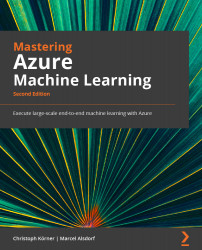Summary
Distributed ML is a great approach to scaling out your training infrastructure in order to gain speed in your training process. It is applied in many real-world scenarios and is very easy to use with Horovod and Azure Machine Learning.
Parallel execution is similar to hyperparameter searching, while distributed execution is similar to Bayesian optimization, which we discussed in detail in the previous chapter. Distributed executions need methods to perform communication (such as one-to-one, one-to-many, many-to-one, and many-to-many) and synchronization (such as barrier synchronization) efficiently. These so-called collective algorithms are provided by communication backends (MPI, Gloo, and NCCL) and allow efficient GPU-to-GPU communication.
DL frameworks build higher-level abstractions on top of communication backends to perform model-parallel and data-parallel training. In data-parallel training, we partition the input data to compute multiple independent parts of the...



